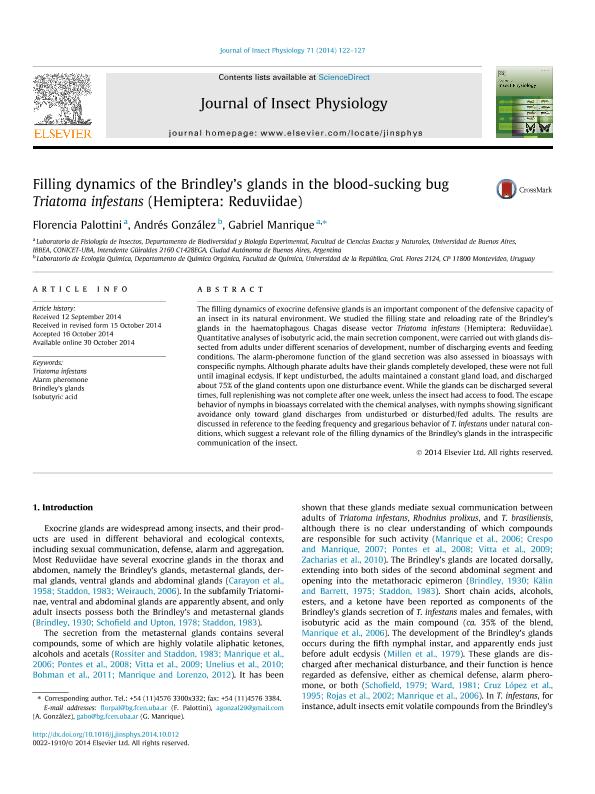Artículo
Filling dynamics of the Brindley’s glands in the blood-sucking bug Triatoma infestans (Hemiptera: Reduviidae)
Fecha de publicación:
12/2014
Editorial:
Elsevier
Revista:
Journal of Insect Physiology
ISSN:
0022-1910
Idioma:
Inglés
Tipo de recurso:
Artículo publicado
Clasificación temática:
Resumen
The filling dynamics of exocrine defensive glands is an important component of the defensive capacity of an insect in its natural environment. We studied the filling state and reloading rate of the Brindley’s glands in the haematophagous Chagas disease vector Triatoma infestans (Hemiptera: Reduviidae). Quantitative analyses of isobutyric acid, the main secretion component, were carried out with glands dissected from adults under different scenarios of development, number of discharging events and feeding conditions. The alarm-pheromone function of the gland secretion was also assessed in bioassays with conspecific nymphs. Although pharate adults have their glands completely developed, these were not full until imaginal ecdysis. If kept undisturbed, the adults maintained a constant gland load, and discharged about 75% of the gland contents upon one disturbance event. While the glands can be discharged several times, full replenishing was not complete after one week, unless the insect had access to food. The escape behavior of nymphs in bioassays correlated with the chemical analyses, with nymphs showing significant avoidance only toward gland discharges from undisturbed or disturbed/fed adults. The results are discussed in reference to the feeding frequency and gregarious behavior of T. infestans under natural conditions, which suggest a relevant role of the filling dynamics of the Brindley’s glands in the intraspecific communication of the insect.
Palabras clave:
Triatoma Infestans
,
Alarm Pheromone
,
Brindley´S Glands
,
Isobutyric Acid
Archivos asociados
Licencia
Identificadores
Colecciones
Articulos(IBBEA)
Articulos de INSTITUTO DE BIODIVERSIDAD Y BIOLOGIA EXPERIMENTAL Y APLICADA
Articulos de INSTITUTO DE BIODIVERSIDAD Y BIOLOGIA EXPERIMENTAL Y APLICADA
Citación
Palottini, Florencia; Gonzalez, Andrés; Manrique, Gabriel; Filling dynamics of the Brindley’s glands in the blood-sucking bug Triatoma infestans (Hemiptera: Reduviidae); Elsevier; Journal of Insect Physiology; 71; 12-2014; 122-127
Compartir
Altmétricas




